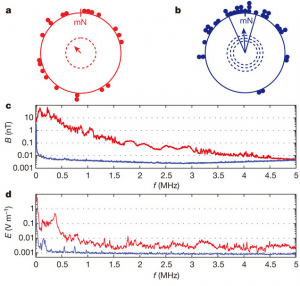While many organisms have impeccable sight, hearing, or smell, some species are able to sense aspects of their environment through mediums that humans cannot naturally perceive. For example, night-migratory songbirds have the ability to use the Earth’s magnetic field to spontaneously orient during the migratory season. Although we’ve known about magneto-reception in migratory birds and a variety of other species for decades, we have yet to fully understand how the use of man-made electronics that emit a range of electromagnetic waves affect a bird’s behavior and ability to rely on the Earth’s magnetic field for navigation. A recent study from the University of Oldenburg demonstrates that even the smallest electromagnetic noise from man-made devices can affect the migratory European robin’s ability to perceive the Earth’s magnetic field, which ultimately renders the bird unable to orient in the proper migratory direction.
In the study, researchers tested the ability of European robins to spontaneously orient under a variety of electromagnetic conditions. The tests were conducted in wooden huts lined with aluminum shielding that had the ability to block and unblock anthropogenic electromagnetic noise. European robins used in the experiment were individually placed in covered bowl-like containers lined with scratch paper for an overnight period during either the fall or spring migratory season. Upon removing the birds from the containers, the scratch paper illustrated the direction in which the birds had tried to escape. This direction should signify the spontaneous orientation that is caused by the birds’ magnetic compass.

Figure 1a. In unscreened wooden huts, European robins were disoriented 1b. After installing grounded aluminium screens, the birds oriented highly significantly towards North in spring 1c & d. Anthropogenic electromagnetic noise in the huts before (red) and after (blue) installation of screens. 1c illustrates the magnetic (B) components, while 1d are the electric (E) components of the measured electrical fields.
In the ungrounded hut with normal levels of unblocked anthropogenic electromagnetic noise, birds were unable to orient properly, as illustrated by the unfocused and sporadic directionality of the scratch marks (Figure 1a). In the grounded hut, which blocked anthropogenic electromagnetic noise, the birds easily oriented and the scratch marks were significantly located on one side of the bowl (Figure 1b).
Interestingly, the study also found that the effects of of anthropogenic electromagnetic noise are not limited to a specific frequency or part of the radiofrequency spectrum. Experiments using the European robins were continued with deliberately introduced broadband electromagnetic noise in either the frequency range from ca. 20 kHz to 450 kHz or from ca. 600 kHz to 3 MHz that was broadcast within the wooden huts. As a control, birds were exposed to low amplitude broadband noise ranging from ca. 2 kHz to 9 MHz. While the control birds were able to orient successfully, birds exposed both of the previously described frequency ranges were unable to orient using their magnetic compasses.
This study has just begun to explore the significance of anthropogenic influences on sensory ecology and has greatly advanced the study of magnetoreception in migratory birds. However, with populations of night-migratory songbirds in rapid decline, a better understanding of the previously overlooked effects of anthropogenic electromagnetic noise on migration success may be most helpful in future conservation efforts. Night-migratory songbirds use the Earth’s magnetic information on the ground and in flight, mostly below altitudes of 1,000 meters. If anthropogenic electromagnetic noise alters or prevents the use of these magnetic compasses, the survival of migratory birds are in jeopardy. Nonetheless, many migratory songbirds are able to navigate well enough to find their way even with the present anthropogenic electromagnetic disruptions. In order to understand the extent to which man-made electromagnetic noise is influencing songbird migration, further research on this subject is required.
Engels, Svenja, Nils-Lasse , Schneider, Nele Lefeldt, Christine Maira Hein, Manuela Zapka, Andreas Michalik, Dana Elbers, Achim Kittel, P. J. Hore, and Henrik Mouritsen. “Anthropogenic Electromagnetic Noise Disrupts Magnetic Compass Orientation in a Migratory Bird.” Naure (2014): n. pag. Nature. 07 May 2014. Web. 09 May 2014.


it’s mean that electronic can find the lost bird?